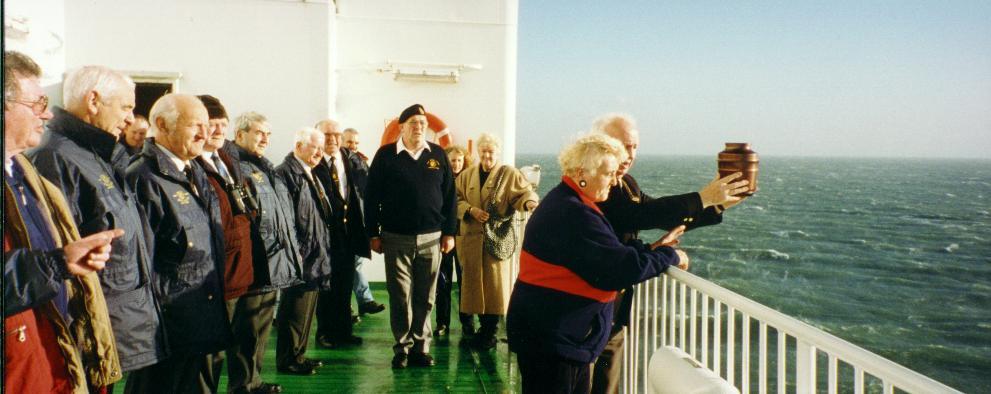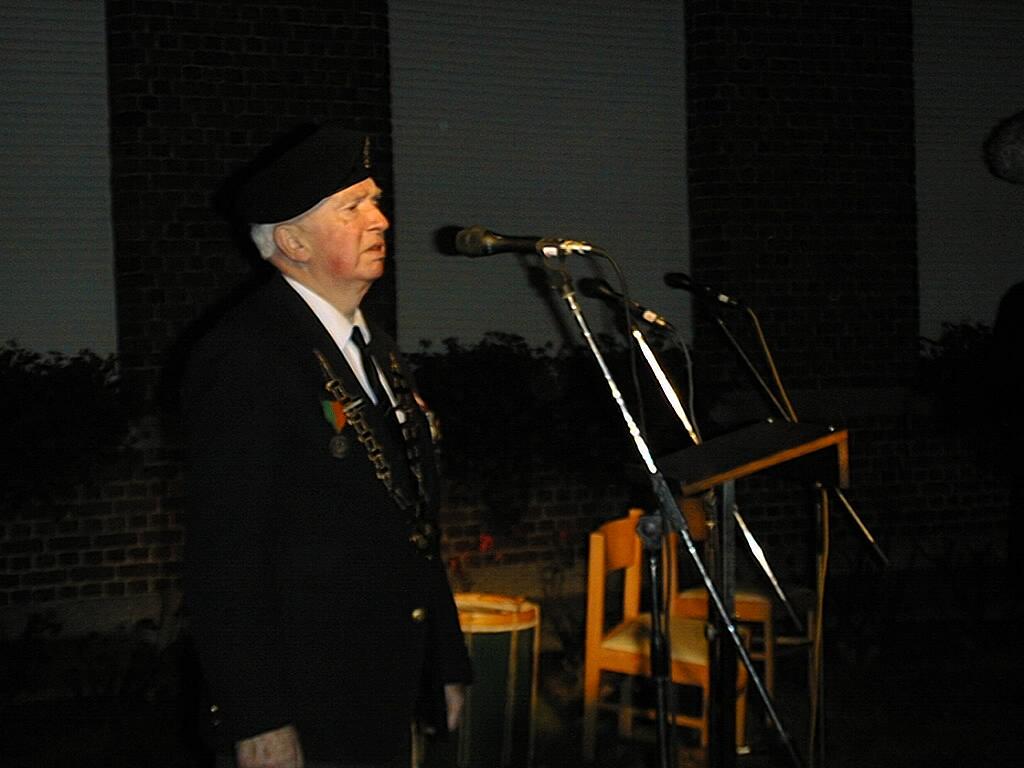|
Irish Naval Association visit the Western Front November 9th, 1998. |

|
| The President of the Naval Association, Piaras O'Connor, accompanied by Angela, scatter her husband's ashes onto the Irish Sea. |
|
Tuesday, 10th November
Major Redmond was a Nationalist MP in Ireland prior to heading off to the Western Front. On hearing of the Easter Rebellion in Ireland in 1916, he was very upset that the leaders of the Rising were executed. So much so, he left instructions that, should he be killed during the war, he did not want to be buried in a British cemetery. Mortally wounded, Major Redmond was taken to an Orphanage at Loker, not far from Messines. He died soon afterwards. Major Redmond, according to his wishes, was buried outside the walls of the British military cemetery at Loker.
Wednesday 11th November. (80th anniversary of the ending of WW1) A coach, with 41 members of the Irish Army from Collin's Barracks, Cork, together with the Naval Association in their coach, departed Lille and headed for the Last Post Ceremony at Ypres. This memorial is dedicated to all who died there, after their victories at Messines in July 1917. Both divisions, the 16th (Irish), and the 36th (Ulster), went on to fight at Passchendale near Ypres and were slaughtered. Theirs are amongst the 74,000 names on the memorial to the missing at Ypres. They drowned in mud, to tired to struggle to safety, or were blown to pieces by shell, or riddled by machine gun bullets.
In the two weeks prior to going over the top, 2000 Irish died in their trenches. They lay, soaked to the skin, in these swamped and rat infested trenches. In heavy torrential rain, gassed and shelled constantly, there was no let up for those two weeks. No fresh water or food could be brought to them so bad was the shelling. They suffered in terrible conditions. Istead of being relieved, these tired and traumatised soldiers, were ordered to attack up a muddy hill, which by now had turned into a quagmire. They advanced, only to be cut to pieces or drown in the mud filled shell holes that they stumbled into. There was no escape. The 16th (Irish) and the 36th (Ulster) Divisions never recovered, and the complete lack of feeling, displayed by their Commanders, directing the war in safety from well behind the front lines, has been a contentious issue that time has not forgotten. |

|
|
Members of the Irish Army from Cork, and The Naval Association, lay a wreath at the memorial to the Munster Regiments, outside St Martins's Cathedral, Ypres.
(the memorial by architect T.A. O'Connell was a tribute from the City of Cork, Ireland)
Following the Last Post ceremony at 11am at the Menin Gate, we headed off to Messines. On arrival at the entrance to the Peace Park, we were escorted to our seats in stand E. We could not have asked for better seating and all had an excellent view of the proceedings. It was both a moving and historic occasion as we watched British and Irish dignitaries arrive for the ceremony. Great credit is due to Paddy Harte, from the Republic of Ireland, and Glen Barr, from the North of Ireland, who were jointly responsible for this great event.
The Irish Peace Park and Round Tower dedicated to the Irish who fought and died during WW1. These men have long been forgotten throughout most of the Republic of Ireland. Until now!! Everyone present felt a sense of emotion at the sight of the Irish and British Army working together at the ceremony. The joint Military Bands from Ireland and Britain marched together into the Peace Park, and performed under the baton of Comdt. Joe Ryan, the Irish Army Musical Director.The icing on the cake was the arrival of Queen Elizabeth ll of the United Kingdom, together with the King and Queen of Belgium, who came to witness the Inauguration of the Round Tower, by the Irish President, Mary McAleese. The Tower and Peace Park are dedicated to the men of the 10th (Irish),16th (Irish) and 36th (Ulster) Divisions who fought during WW1. It was at Messines Ridge in July 1917 that one of the few early victories of the war was gained. Messines Ridge was a vital stronghold held by the Germans since 1914. This ridge overlooked the town of Ypres with a very clear view of the surrounding area. It was important to the Allies that this ridge be taken at all cost, if the stalemate of the trench warefare was to be broken. 20 deep tunnels had been dug under this ridge which took 18 months to complete. Each tunnel was packed with high explosives. On the morning of 1st June 1917 the tunnels with 1,700,000 Lbs of high explosives were detonated under the Germans. This was followed by an attack by both the 16th (Irish) and 36th (Ulster) Divisions, who, for the first time, fought and died together, side by side, all problems in Ireland left to one side.
See the memorial page to the grandfather of our member
Senior Chief Petty Officer Con Donovan (SM) and his brother former Petty Officer Paddy Donovan (SM) who have found the grave with the help of the Commonwealth War Graves Commission. Both will be part of the visiting group to Flanders and the Somme and will lay a wreath at their grandfathers grave on Tuesday 7th September 1999.
|
|
During our visit we were invited guests at Messines for the inauguration of the "Island of Ireland Peace Tower and Park" The 100 feet tall tower modelled on an Irish round tower, marks the area of the Island of Ireland Peace Park. The Park was inaugurated by the President of Ireland Mrs.Mary McAleese and HM Queen Elizabeth on 11th November 1998 in the presence of the King and Queen of the Belgians. The Park commemorates Irishmen of both Catholic and Protestant traditions who fought side by side during the First World War. Over 50,000 men from the Island of Ireland died fighting in the war. The tower, faced in stone from St. Mary's Hospital in Mullingar in Ireland, (the first Victoria Cross of WW1 was awarded to Maurice Dease who was from Mullingar) includes stones from every county in Ireland as well as a piece of limestone from Temple bar are in Dublin (Temple bar is now a hive of activity in the evening for the young and old and in particular overseas visitors who like to sample the Irish night life). The tower is surrounded by four gardens representing four provinces and is designed so that the sun's rays enter the tower at 1100 hours on the 11th November. The project was the idea of Paddy harte, former Fine Gael TD for Donegal North East, and Glen Barr once a senior member of the Ulster Defence Association, both of whom spoke during the dedication ceremony. The building of the tower was assisted by a team of 36 young people who in groups of 12 had attended training courses in belfast and Dublin. The memorial is the first physical symbol of remembrance of all the Irishmen who died in the war. It stands in an area where the two Irish Divisions on the Western Front, the mainly Nationalist 16th Irish Division and the predominately Unionist 36th Ulster Division, fought side by side in 1917 and won a resounding victory. President McAleese finished her speech by saying " We hope that the goal of peace promised in the good Friday Agreement will be our gift to the next generation. I wish to thank you most sincerely for affording me the opportunity of commemorating the memory and honouring the sarcrifice of those from the Island of Ireland who died in the Great War.
|
| See the following web-sites :- |
| Major William Redmond |
| The 16th (Irish) Division |
| The 36th (Ulster) Division by Karl W. Murray |
| The Great War by Karl W. Murray |

